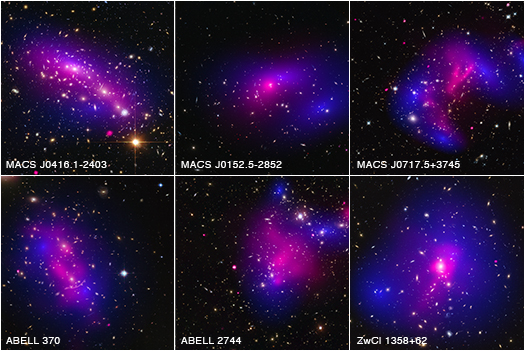Dark Matter is Darker Than Once Thought
This panel of images represents a study of 72 colliding galaxy clusters conducted by a team of astronomers using NASA's Chandra X-ray Observatory and Hubble Space Telescope. The research sets new limits on how dark matter - the mysterious substance that makes up most of the matter in the Universe - interacts with itself, as reported in the press release. This information could help scientists narrow down the possibilities of what dark matter may be.
Galaxy clusters, the largest objects in the Universe held together by their own gravity, are made up of three main components: stars, clouds of hot gas, and dark matter. When galaxy clusters collide, the clouds of gas enveloping the galaxies crash into each other and slow down or stop. The stars are much less affected by the drag from the gas and, because they occupy much less space, they glide past each other like ships passing in the night.
Because the clouds of gas are very hot - millions of degrees - they glow brightly in X-ray light (pink). When combined with visible-light images from Hubble, the team was able to map the post-collision distribution of stars and also of the dark matter (blue). Astronomers can map the distribution of dark matter by analyzing how the light from distant sources beyond the cluster is magnified and distorted by gravitational effects (known as "gravitational lensing.")
The collisions in the study happened at different times, and are seen from different angles - some from the side, and others head-on. The clusters in the panel are from left to right and top to bottom: MACS J0416.1Â2403, MACS J0152.5-2852, MACS J0717.5+3745, Abell 370, Abell 2744 and ZwCl 1358+62.
More information at http://chandra.harvard.edu/photo/2015/dark/index.html
-Megan Watzke, CXC
Please note this is a moderated blog. No pornography, spam, profanity or discriminatory remarks are allowed. No personal attacks are allowed. Users should stay on topic to keep it relevant for the readers.
Read the privacy statement

